Oh! Nuts ◊ Bulk Nuts & Seeds ◊ Bulk Pistachios
Bulk Pistachios
Browse our complete selection of Bulk Pistachios
 | |||
 | |||
 | |||
 | |||
 | |||
 | |||
 | |||
 | |||
 | |||
Ultimate Guide to Nuts
MORE ON PISTACHIO NUTS
How long have pistachio nuts been around?
There is plenty of evidence suggesting that pistachio nuts were popular thousands
of years ago. The pistachio tree probably originated in western Asia and
Asia Minor, but it is found growing wild as far eastward as Pakistan and
India. In Iran and Afghanistan, the nuts from wild pistachio trees are smaller
than cultivated varieties, and they have an unusual, rather sharp, taste.
This appeals to the nomadic tribes that live in these remote, inhospitable
regions. Historically, the wild pistachio has been to the Asian nomad what
the pine nut once was to the Indian in the American Southwest.
Where do pistachio nuts grow?
Most of the world?s pistachios are produced in Iran, Turkey and California.
Some pistachio nuts are also grown in Syria, Afghanistan, Italy, India, Greece,
Pakistan and Tunisia.
For hundreds of years pistachios have mostly been harvested from wild or semi-wild
trees in the Middle East and Central Asia. However, around 1900, it became
apparent that pistachios could be marketed profitably in the U.S. and Europe.
Therefore, attention was devoted to developing formal, cultivated pistachio
orchards, mainly in Iran and Turkey. In Afghanistan, small nuts that have the
perfect green color are still harvested from wild trees. Unfortunately many
wild pistachio trees have been eliminated due to forest clearance, destructive
grazing by goats and the use of pistachio wood for making charcoal.
In Iran several excellent cultivars have recently been developed. In fact,
Iran was the top supplier of pistachio nuts to the U.S. in 1979, providing
20 million pounds of nuts. When American hostages were seized in Iran and imports
were cut back, the total of pistachios imported in the U.S. from Iran fell
to 1 million pounds. As of now, there is so much political turmoil in Iran
that the pistachio trade has been disrupted entirely, and prices have skyrocketed.
Another large supplier of pistachios to the U.S. is Turkey. Turkey has also
selected and developed some promising cultivars. Most of the Turkish pistachio
nuts come from the dry, barren foothills in western and southeastern Turkey.
What is the pistachio?
The pistachio is a member of the same botanic family (Anacardiaceae) as cashew,
mango, sumac and poison oak. There are about a dozen or so species of Pistacia.
Some, such as P. terebinthus, the ?turpentine tree? of Cyprus,
exude turpentine. In fact, the turpentine of this species is so superior in
quality to the common turpentine from the Scotch Pine, that it sells for a
much higher price. Others, especially the mastic tree (P. lentiscus), are a
source of a high-grade resin from which transparent varnishes are made, and
of mastic, the main ingredient used in the Orient in the manufacture of chewing
gum. In Turkey mastic is also used in the production of liquor. A few Pistacia
trees produce small nuts. In the Middle East, an excellent edible oil is made
from the very small, crushed nuts of P. terebinthus and P. atlantica. P. terebinthus,
is the terebinth tree of the Bible, whose spreading branches provided shade
for nomadic wanderers of patriarchal age.
The edible nuts of commerce that we are familiar with are produced only by
P. vera, though seedlings of the aforementioned two species are used as rootstocks
for budding and grafting P. vera.
How does the pistachio grow?
The pistachio tree grows slowly, eventually reaching a height and spread of
25 to 30 feet. It has no problem growing in poor soil and adverse climate
conditions, such as low annual rainfall and stony terrain. It can grow quite
well on steep, rocky slopes suitable only for goats. Though it can endure
drought, it cannot survive in wet earth, thus it is very important to ensure
the soil is well-drained. It grows best where winters are cool enough to
break bud dormancy and where summers are long and hot enough for proper ripening
of the nuts. The tree can handle cold and wind but not dampness and high
humidity. Some of the areas in Iran where pistachios flourish have temperatures
ranging from 15°F in the winter to over 110°F in the summer. The
pistachio is a good candidate for developing some arid regions throughout
the third world, where it is almost impossible to grow any other crop because
of low rainfall.
A major difference between the pistachio and other popular dessert nuts is
the characteristic green of its kernel. The entire kernel, not just its surface,
has this coloration. Generally, nuts of a deeper green shade are more valued.
The fruit grows in clusters, resembling grapes. The oblong kernel is covered
with a thin, ivory-colored bony shell. When conditions are favorable, the shells
split longitudinally prior to harvest, having the appearance of a laughing
face. This is a desirable characteristic since the nuts are usually marketed
in-shell, and when the shell is split it is easier to extract with the fingers.
In unfavorable weather or other adverse conditions during nut growth and development,
the shells remain closed. Turkish growers have a sorrowful expression to describe
this unfortunate turn of events: ?Too bad, the pistachios are not laughing.? Unsplit
nuts are not popular with the consumer and sell for a lower price.
How are pistachios cultivated?
The pistachio is usually propagated in California by budding or grafting selected
scions of P. vera onto seedling rootstocks of P. atlantica, P. terebinthus
and P. integerimma, These rootstock species are used because of their vigor
and resistance to nematodes and soil borne fungi.
The pistachio is dioecious: male and female flowers, both of which are small
and without petals, are borne on separate trees. The pollen is carried from
male to female flowers by the wind. In California, Kerman is the most common
female cultivar, while Peters is a prolific pollen producer. One male Peters
tree can easily pollinate 8 or 10 female Kerman trees. When male trees are
planted in an orchard, they are placed in locations where they will take advantage
of prevailing winds.
The orchard should be established in deep, friable, well-drained soils to obtain
maximum growth and productivity. Young pistachio trees are generally spaced
11 to 15 feet between trees in the row, and 22 to 30 feet between rows, depending
upon soil conditions. Years later, when the trees become crowded, every other
tree in the row may be removed to leave the remaining trees on a square.
Pruning is important during the early years of an orchard. High-headed trees
permit easy maintenance with mechanical orchard equipment. Strong crotches
should be developed to withstand the stress later on of power-driven shakers
during the harvest.
Pistachio trees begin producing nuts in about 6 or 7 years. However, it is
usually in the 15th to 20th year that full bearing is attained. 50 pounds of
dry, hulled nuts per tree is a considered a good harvest. The trees do tend
to bear a heavy crop one year, followed by little or none the following year,
in a system of ?biennial bearing?. A pistachio tree can live and
produce for centuries if conditions are right. In the Kerman region of Iran,
there is a pistachio tree that is seven-hundred years old.
Although the pistachio tree can produce some nuts in poor growing conditions,
its highest yields occur, of course, in an optimum agricultural environment.
Like other fruit and nut trees, it responds very well to proper irrigation
and application of fertilizer.
The most serious plant disease threatening the growth of pistachio trees in
California is Verticillium wilt, a soil-borne fungus. It can quickly kill the
trees. Since this fungus is frequently found in cotton, it is not a good idea
to plant pistachio trees on land that was previously used for cultivating cotton,
unless the soil is fumigated prior to planting.
Where do pistachios grow in the U.S.?
The only state which produces pistachios on a commercial scale is California,
with approximately forty thousand acres planted. Trial plantings have also
been attempted in Arizona and New Mexico. According to the California Pistachio
Association, founded in 1972 and located in Fresno, the total crop is around
80 million pounds. About one-third is exported.
A pistachio boom in California in 1928 failed in the 1930?s because American
growers depended on hand labor in those days. Despite the Depression, manual
labor was comparatively expensive, and could not compete with cheap foreign
labor in growing, harvesting and processing the nuts. Times have changed; foreign
pistachio picking and processing still depends almost entirely on hand labor,
while the California industry has become thoroughly mechanized.
Foreign vs. home-grown pistachios
Outside the United States, methods of harvesting pistachios are primitive.
Women do most of the work. In Iran the ripened nuts are picked by hand or
knocked off the trees with poles onto burlap spread on the ground. Some are
hulled as soon as possible following the harvest, but the majority is dried
in the hull to be hulled at a later convenient time. At that time, the nuts
are soaked in water, which enables them to be easily removed by squeezing
between the fingers.
Then the nuts are usually spread out in the sun to dry on stone, concrete or
earth floors. Because of these crude harvesting and hulling methods, nutshells
may be blemished and stained, appearing unappetizing. Importers in the U.S.
use a non-toxic, red, food-grade dye to give the nuts visual appeal. Pistachio
nuts may be coated with a thin layer of cornstarch and salt.
The relative merits of home-grown vs. foreign-grown pistachios is a controversial
subject. American importers of Iranian and Turkish pistachios describe California
pistachios as beautiful but tasteless. The California producers, on the other
hand, claim their pistachios taste about the same as the imported nuts but
are larger, fresher and easier to open.
When was the pistachio introduced into the U.S.?
In 1854 the Commissioner of Patents distributed seed for experimental plantings
of pistachio in California, Texas and other southern states. In 1875 a few
small pistachio trees, imported from France, were planted in Sonoma, California.
During the late nineteenth century, imported pistachios were popular among
American immigrants from the Middle East. They were found in ethnic food shops,
especially in New York City. In the 1920?s and 1930?s the colorful
red- and white-coated nuts became available to the general public. They cost
5¢ per dozen nuts in vending machines located in subway stations and other
public places. In those days these small-bulk nut-vending machines accounted
for most pistachio nut sales.
In the early twentieth century the U.S. Department of Agriculture assembled
a collection of Pistacia species and pistachio nut varieties at the Plant Introduction
Station in California. In 1929 a U.S.D.A. plant explorer visited Iran and Turkestan
to study pistachios. He brought back seed selected from about 90 different
sources. One of these was later named Kerman, from the district of that name
in Iran. Kerman eventually developed into a most important plant cultivar because
of its large nut size and high percentage of split shells.
Harvesting pistachios
Under normal conditions the nuts hang well and may be left on the tree until
most are ripe. At that time a single shaking will bring down the bulk of
the mature nuts. Sometimes, trees that have just started to bear nuts are
harvested by shaking the nuts from the trees onto canvas. Otherwise most
are harvested mechanically by prune- or soft fruit-type harvesting equipment
which consists of a shaker and a catching frame. A conveyor belt is positioned
on both sides of the tree, carrying the nuts past a primary cleaner and deleafer,
then dumping them into movable bins to be hauled to the processing plant.
Two skilled machine operators can harvest about 1 acre of pistachios per
hour.
Processing pistachios
Soon after being harvested, pistachio nuts must be hulled and dried. In fact,
this has to be accomplished within 24 hours for the nuts to maintain their
high quality and unblemished appearance. There are 3 types of machines that
are useful in hulling pistachios. Abrasive vegetable peeling machines produce
an attractive product but are limited to a batch of no more than 50 or 60 pounds
at a time. Currently the harvest in California is so large that these machines
are not suitable for this purpose. Then there are modified walnut dehulling
machines that are quite satisfactory. But the bulk of the crop is hulled in
machines consisting of 2 parallel rubberized belts rotating in the same direction,
at different speeds. The nuts are fed continuously between the adjustable belts
and emerge without hulls at the other end. Then they are washed and separated
from stray blanks (empty shells) and immature nuts in a float/sink mechanism,
where the empty blanks will float, while the mature, filled nuts will sink.
The nuts are dried with forced air at 150°-160°, reducing the moisture
content, which may have been up to 45% in the freshly harvested nuts, to 5%
in about ten hours. ?Electric eye? sorters remove blemished nuts,
which can be dyed red or white and sold as dyed nuts, or shelled to be sold
as nutmeats. Good quality splits are graded to four sizes, roasted, salted
and packaged. About 90% of California pistachios are sold roasted and salted
in their shell for snacking. Shelled pistachios are used commercially in confectionery,
ice cream candies, sausages, bakery goods and flavoring for puddings.
The size of pistachio nuts is expressed by the number of nuts per ounce. Iranian
pistachios range from 18 to 40 nuts per ounce, while California nuts are larger ? sometimes
as few as 14 to the ounce. Since pistachio kernels are rather small and expensive
they are, as a rule, not included in salt mixes with other larger tree nuts.
Pistachios nuts are rich in oil, but due to the high price of the nuts, it
does not pay to produce pistachio oil commercially.
Tree nuts are usually marketed ?in-shell? or ?shelled?.
Pistachios and filberts are usually sold ?in-shell? to the retail
trade, while almonds and pecans are generally sold shelled to the industry,
which consists primarily of salters, confectioners, bakers and ice cream manufacturers.
The pistachio nut is unique in the nut trade due to its semi-split shells.
This enables the processor to roast and salt the kernel without removing the
shell, while it also serves as a convenient form of natural packaging.

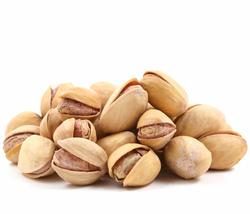



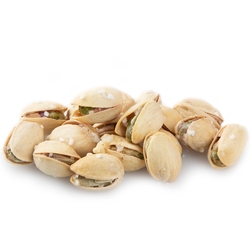
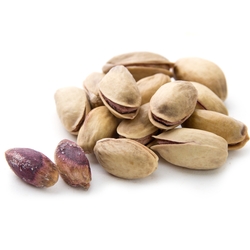
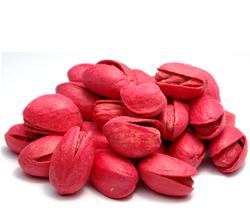
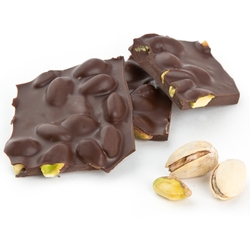
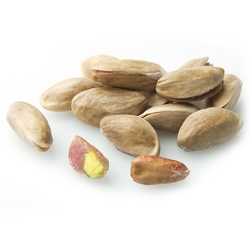
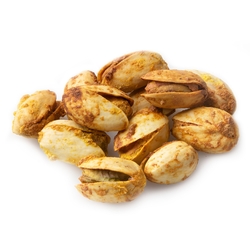
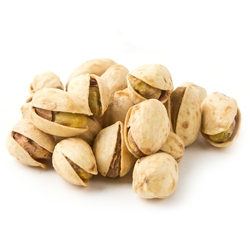
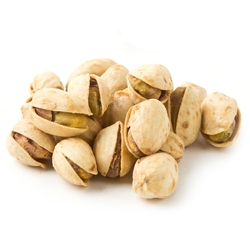
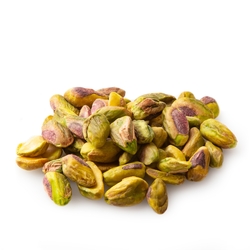
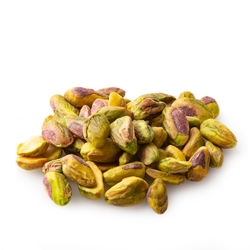
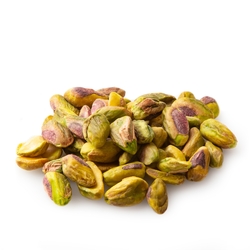
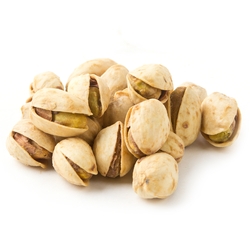
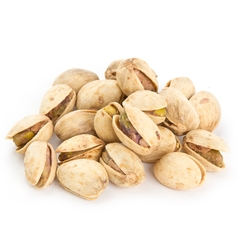
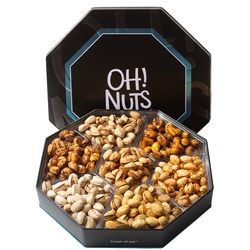
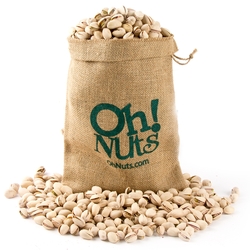
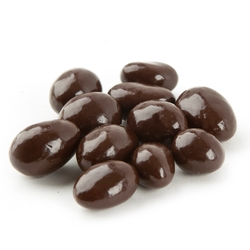
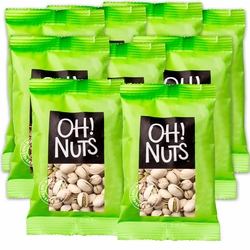
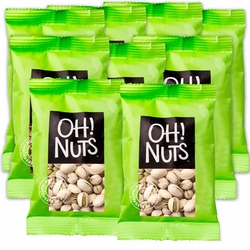
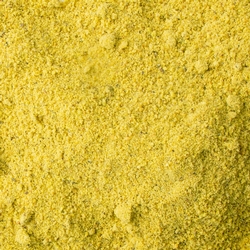
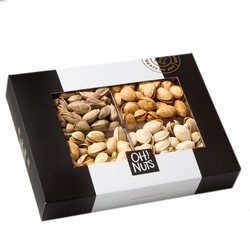
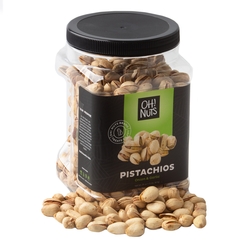
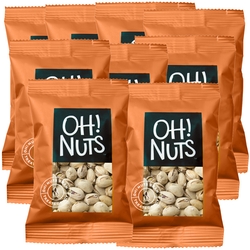
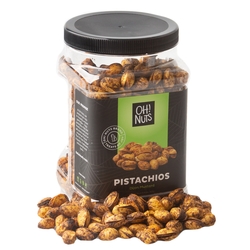
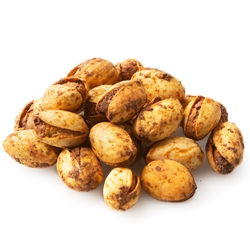
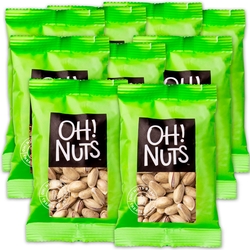
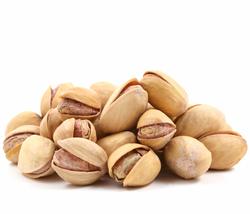
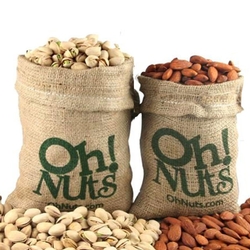
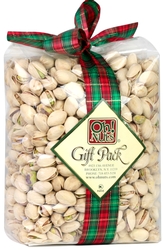
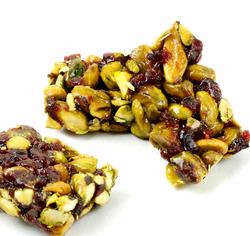
 or
or 
